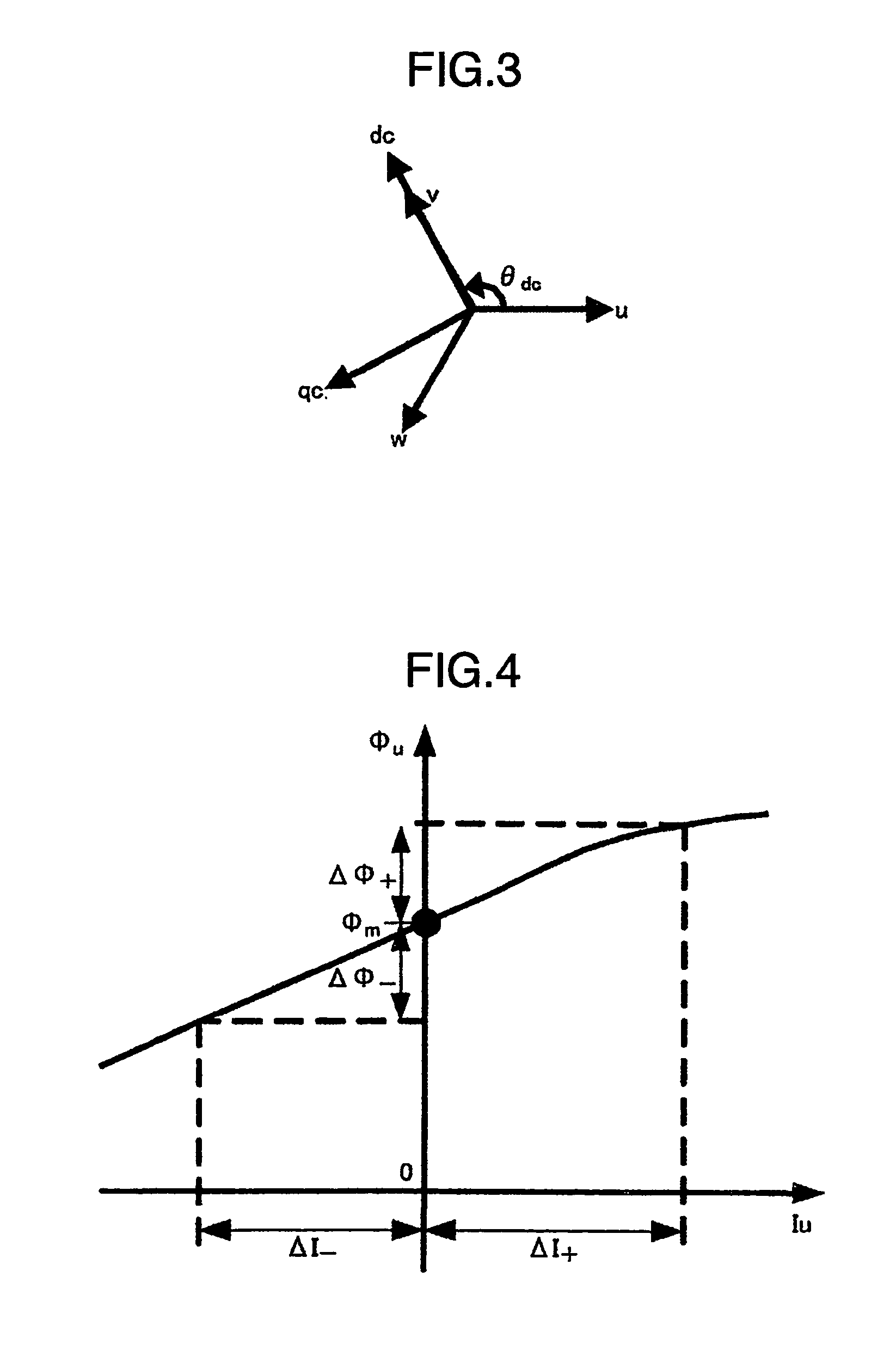Driving system of permanent magnet synchronous motor
a synchronous motor and driving system technology, applied in the direction of electric controllers, electronic commutators, dynamo-electric converter control, etc., can solve the problems of large estimation error, inability to accurately calculate the disclosed current change quantity, and large position estimation error, so as to improve the starting torque of the driven motor, improve the accuracy of estimation, and reduce the effect of noise caused by a pulsating current at the time of initial position estimation
- Summary
- Abstract
- Description
- Claims
- Application Information
AI Technical Summary
Benefits of technology
Problems solved by technology
Method used
Image
Examples
first embodiment
[0077]FIG. 1 is a configuration diagram of a driving system of permanent magnet synchronous motor according to the present invention. The driving system includes a permanent magnet synchronous motor 103 to be controlled, a power converter 102 for driving the permanent magnet synchronous motor 103, and a control apparatus 101 for controlling the power converter 102 and the permanent magnet synchronous motor 103. The control apparatus 101 includes a unit having a dc axis which is a phase axis for applying a high frequency voltage to the permanent magnet synchronous motor 103 and a qc axis perpendicular to the dc axis and providing a voltage command value of a high frequency component on the dc- and qc-axes, and a unit for detecting a current which flows through a DC resistor 111 in the power converter 102. The control apparatus 101 estimates a magnetic pole position in the permanent magnet synchronous motor 103 on the basis of a difference between a positive side change quantity and a...
second embodiment
[0154]In the second embodiment, the trigger signal TRG is generated at timing of the triangular wave PWM carrier signal becoming a wave crest or wave bottom when the value of the status signal STS is 1 or 3. In the operation waveform example, the TRG signal is output at timing of the PWM carrier signal becoming a wave bottom.
[0155]Phase currents are detected at timing of the pulse output of the trigger signal TRG. Black dots (●) in current waveforms shown in (h) and (i) of FIG. 24 indicate sampled current values. In the present embodiment, the phase current detection unit 115 detects only the U-phase Iu and the V-phase current Iv. The W-phase current Iw which cannot be detected directly is calculated from the detected values of the U-phase and the V-phase on the basis of Equation (9).
Iw=−(Iu+Iv) (9)
[0156]Rhomb marks (⋄) in the current waveform of Iw shown in (j) of FIG. 24 indicate calculated W-phase positive side detected value Iw+ and W-phase negative side detected value Iw−.
[015...
fourth embodiment
[0208]An internal configuration of the three-phase current value detection unit 113″ in the fourth embodiment is shown in FIG. 33. A sampler in the three-phase current value detection unit 113″ samples the detected current Ish at time when the pulse of the trigger signal TRG has become the high level. The trigger signal TRG and sample timing of detected current values utilized for the magnetic pole position estimation are shown in FIG. 32. Black dots (●) in current waveforms shown in FIG. 32(h), (i), (j) and (k) indicate sampled current values. Sampled Ish values are distributed to positive and negative values of respective phase currents on the basis of information of the electric phase angle θdc and the status signal STS. The distribution is conducted according to the following rules.[0209]A sample value of a first point of Ish obtained in response to a TRG signal which is generated when θdc=0 degree and STS=1 is regarded as a U-phase positive side current Iu1+.[0210]A sample valu...
PUM
 Login to View More
Login to View More Abstract
Description
Claims
Application Information
 Login to View More
Login to View More - R&D
- Intellectual Property
- Life Sciences
- Materials
- Tech Scout
- Unparalleled Data Quality
- Higher Quality Content
- 60% Fewer Hallucinations
Browse by: Latest US Patents, China's latest patents, Technical Efficacy Thesaurus, Application Domain, Technology Topic, Popular Technical Reports.
© 2025 PatSnap. All rights reserved.Legal|Privacy policy|Modern Slavery Act Transparency Statement|Sitemap|About US| Contact US: help@patsnap.com



